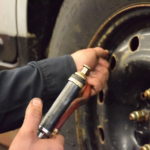Not to cause any undue alarm, but your vehicle could have a ticking time-bomb lying in wait underneath its hood. It’s called the timing belt: and neglecting timing belt maintenance can cause very big problems.
Depending on the year, make and model of your vehicle, there’s a good chance a rubber timing belt is used to control the engine’s valve timing. The belt connects the crankshaft to the camshaft pulleys, which effectively sets the mechanical ‘heartbeat’ of the engine by operating the valves in extremely precise relation to the position of the crankshaft.
Timing belts keep your engine ticking and need to be changed before they break. This isn’t a part that’ll give any sort of warning in the form of a wear indicator, check engine light or alarming noise before it fails. If your timing belt does fail, the only sound you’ll hear is your engine instantly shutting down and stopping your drive dead in its tracks.
The inside of your engine has countless moving parts that spin, slide or reciprocate at thousands of revolutions per minute- all operating within an extremely close proximity to one another. That said, a failed timing belt has the very real potential of destroying your vehicle’s engine from the inside out.
When a neglected timing belt fails and snaps, the camshaft(s) and valves will stop moving- some of them in the open position. This means that the pistons may contact valves, breaking them off inside the engine. Some engines simply cease to work and don’t wind up with internal damage– though many do.
If you drive a Japanese or German car with overhead cams, it’s bad news for your wallet if the belt ever lets go. This will not only cancel your trip, but also leave you with an expensive towing bill, as well as a potential bill for a new engine.
Determine whether or not your engine has a timing belt, and be sure to have it changed ahead of its recommended service interval– which tends to be 160,000 kilometres or less. Check with your owner’s manual to be sure, or consult your dealership or favorite mechanic. Remember, if a timing belt isn’t changed on time winds up snapping and destroying your engine, you won’t be covered by any warranty.
Of course, preventing such nightmares from happening is simple– just stick to your vehicle’s maintenance schedule. This will give you peace of mind and longer engine life, as well as ensuring your warranty in good standing.

Note that your particular vehicle may not have a timing belt at all. A timing chain is another possibility– it does the same job as a timing belt, though it’s generally considered maintenance free as long as owners stay on top of their oil changes.
If you’ve recently bought a used car and are unsure of the condition of its timing belt, or you’ve owned a newer model and want to be safe, talk to a mechanic. The cost of changing this relatively simple part is inexpensive compared to the possible cost of replacing an engine.





